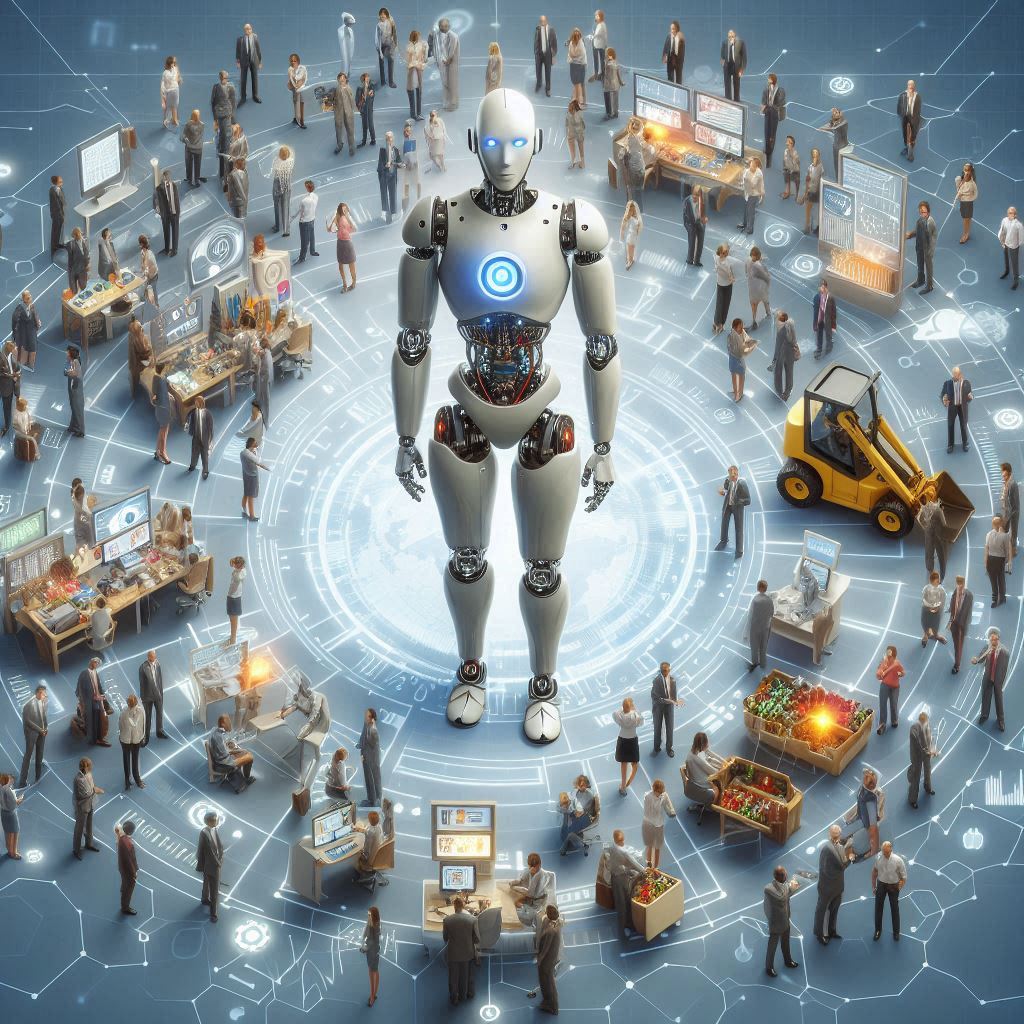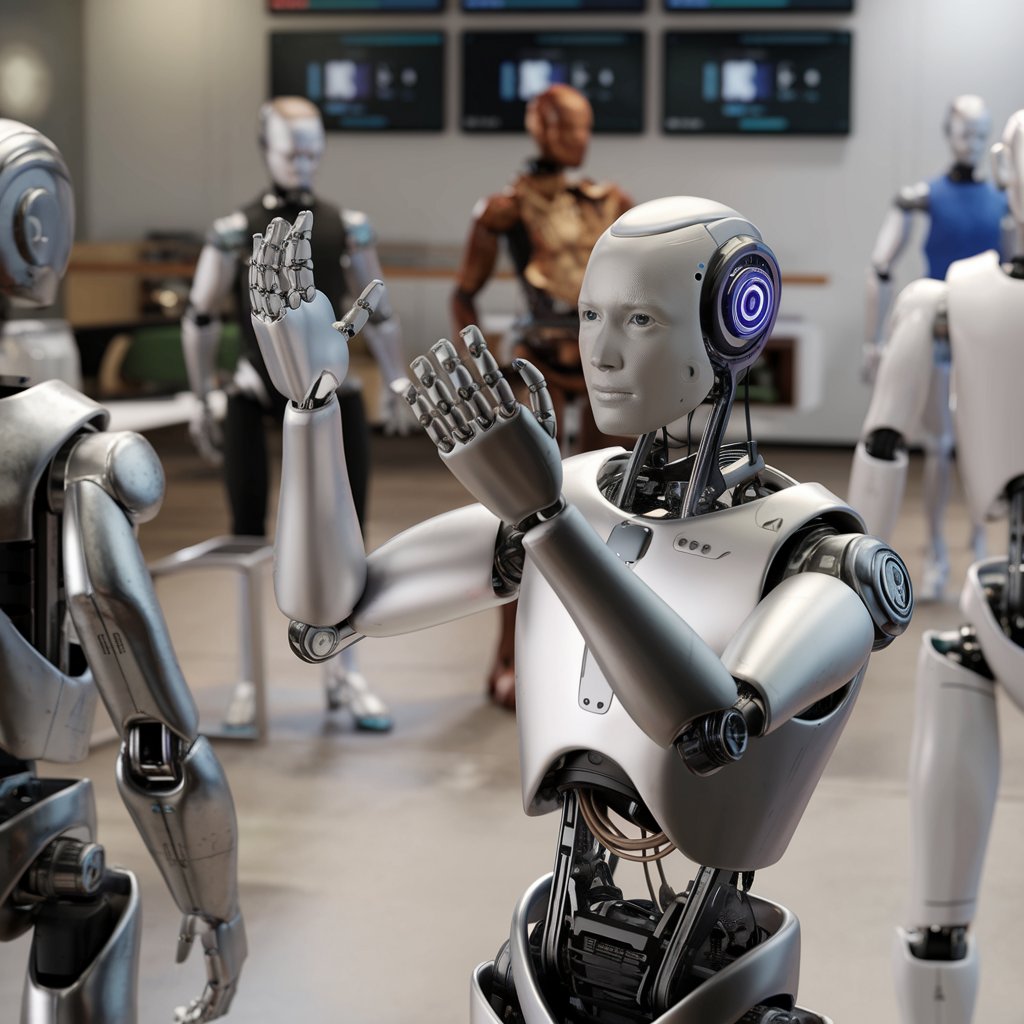The convergence of Artificial Intelligence (AI) and robotics is ushering in a new era of humanoid robots—machines designed to mimic human behavior and interact with the world in a more natural, human-like manner. With the growing sophistication of AI, these robots are becoming increasingly capable of making decisions, adapting to new environments, and performing tasks that were once thought to be exclusive to humans. This fusion of AI and humanoid robotics is not only enhancing the decision-making abilities of robots but also driving the future of automation, making them ready for a wide array of applications in industries such as healthcare, service, education, and beyond.
The Role of AI in Humanoid Robots
Humanoid robots, by design, aim to replicate human physical appearance, movement, and cognitive functions. AI plays a pivotal role in enabling these robots to think, learn, and act like humans. AI-driven humanoid robots rely on several AI technologies, including machine learning, deep learning, natural language processing (NLP), and computer vision, to function autonomously and efficiently.
These robots process sensory inputs (e.g., sight, sound, touch) and analyze the data to make real-time decisions, such as interpreting speech, responding to visual cues, or adjusting behavior based on the context of their surroundings. The integration of AI allows humanoid robots to continuously improve their interactions and learn from each experience, enhancing their ability to adapt to changing environments or tasks.
Enhancing Decision-Making with AI
One of the key advantages of AI integration in humanoid robots is the enhancement of decision-making capabilities. AI algorithms enable robots to process vast amounts of data and make informed decisions quickly. These systems can be trained to recognize patterns, weigh options, and choose the best course of action—much like a human would in a similar scenario.
In practical terms, AI-driven humanoid robots can make autonomous decisions based on the environmental context and real-time inputs. For example, in a healthcare setting, a humanoid robot with AI capabilities could assess a patient’s vitals, detect changes in behavior, and suggest necessary actions, such as alerting a nurse or providing medication instructions. In manufacturing or logistics, humanoid robots can dynamically adjust their workflow based on inventory changes or machine malfunctions, significantly improving operational efficiency.
Increasing Adaptability for Diverse Tasks
The adaptability of AI-driven humanoid robots is one of the most exciting features of this technology. AI-powered machines are able to perform a wide range of tasks and can quickly adapt to new environments, situations, or user requirements. This adaptability is what sets AI-driven humanoid robots apart from traditional, pre-programmed robots.
For example, humanoid robots equipped with AI can learn to perform various tasks by observing humans or interacting with their environment. In educational settings, AI-driven humanoid robots can adapt their teaching styles based on the individual needs and learning progress of students. Similarly, in customer service roles, these robots can modify their responses and behavior depending on the preferences and emotional state of the person they are interacting with.
The ability to learn on the job and continually refine their actions based on experience makes AI-driven humanoid robots more flexible and efficient. With the help of advanced machine learning algorithms, these robots can become more intuitive, helping them take on more complex and creative tasks over time.
The humanoid robot market to grow from USD 2.03 billion in 2024 and is expected to reach USD 13.25 billion by 2029, growing at a CAGR of 45.5% from 2024 to 2029.
Download PDF Brochure @
https://www.marketsandmarkets.com/pdfdownloadNew.asp?id=99567653

Applications of AI-Driven Humanoid Robots
- Healthcare: In hospitals and clinics, humanoid robots powered by AI can serve as assistants to healthcare providers. They can assist with patient monitoring, provide companionship for the elderly or disabled, and even perform specific medical tasks, such as administering basic care or aiding in physical therapy. Additionally, AI allows these robots to process medical data and make decisions related to patient care, improving efficiency and reducing human error.
- Customer Service: Humanoid robots equipped with AI are revolutionizing the customer service industry. They can answer questions, provide product recommendations, and troubleshoot issues, all while adapting to the customer’s needs and maintaining a conversational interaction. Their ability to understand and process natural language makes them an ideal solution for businesses seeking to provide personalized customer experiences.
- Manufacturing and Warehousing: AI-driven humanoid robots in manufacturing environments can handle tasks such as assembly, quality control, and packaging. Their ability to make decisions in real-time helps prevent delays, adapt to unforeseen changes, and optimize workflows, leading to increased productivity. In warehouses, humanoid robots can navigate complex environments, picking and sorting inventory autonomously.
- Education and Training: In educational settings, humanoid robots can serve as interactive tutors or teaching assistants. AI allows these robots to adapt to different learning styles, tailor lessons to individual students, and provide feedback in real-time. For training purposes, they can simulate real-world scenarios, allowing students to practice skills in a safe and controlled environment.
- Entertainment and Hospitality: AI-powered humanoid robots are also making their mark in the entertainment and hospitality sectors. From acting as interactive hosts at theme parks and hotels to providing personalized entertainment experiences, these robots enhance customer satisfaction while offering engaging and dynamic interactions.
Overcoming Challenges in AI-Driven Humanoid Robots
Despite their potential, AI-driven humanoid robots still face several challenges. One of the key hurdles is ethical concerns surrounding AI decision-making, particularly in areas such as healthcare and law enforcement. Ensuring that AI-driven robots act in a way that aligns with human values and ethical standards is critical to their acceptance in society.
Additionally, while AI enhances the robots’ capabilities, achieving true human-like interaction remains a work in progress. Robots must continue to improve in understanding and responding to complex emotions, social cues, and non-verbal communication. This is an area where natural language processing and emotional intelligence research are crucial in advancing the development of more responsive and adaptive humanoid robots.

The Future of AI-Driven Humanoid Robots
Looking ahead, the integration of AI into humanoid robots will only become more advanced, enabling machines to perform increasingly sophisticated tasks. With improved learning algorithms, better sensory perception, and more adaptive decision-making systems, humanoid robots will continue to redefine what is possible in automation, healthcare, service industries, and beyond.
The future-ready machines that emerge from these innovations will be able to seamlessly integrate into our daily lives, complementing human workers and enhancing the overall efficiency of various industries. As technology continues to evolve, AI-driven humanoid robots will serve as valuable companions and partners, helping us solve complex problems and improve our quality of life.
AI-driven humanoid robots represent a significant leap forward in both robotics and artificial intelligence. By enhancing decision-making capabilities and increasing adaptability, these robots are poised to tackle a wide range of real-world challenges across industries. As they continue to evolve, they will not only transform how businesses operate but also how humans interact with machines, leading to a future where humanoid robots work alongside us to create more efficient, dynamic, and sustainable solutions.
Frequently asked questions (FAQs) about AI-Driven Humanoid Robots:
1. What is an AI-driven humanoid robot?
An AI-driven humanoid robot is a robot designed to resemble human appearance and behavior, enhanced with artificial intelligence technologies. These robots are capable of learning, decision-making, and adapting to various environments and tasks using AI techniques such as machine learning, natural language processing, and computer vision.
2. How do AI-driven humanoid robots make decisions?
AI-driven humanoid robots make decisions through the processing of large amounts of data gathered from their environment (visual, auditory, and sensory data). Using algorithms like machine learning, these robots can identify patterns and choose the most suitable course of action based on their training, past experiences, and real-time inputs.
3. What are the main benefits of AI in humanoid robots?
The main benefits of AI in humanoid robots include:
- Enhanced decision-making: Ability to make informed decisions quickly.
- Adaptability: Robots can adjust their actions and behavior depending on different contexts and environments.
- Learning capabilities: They can improve their performance over time by learning from past experiences and real-time data.
- Automation: AI-driven robots reduce human intervention, increasing productivity and efficiency.
4. What industries are using AI-driven humanoid robots?
AI-driven humanoid robots are being used in various industries such as:
- Healthcare: Assisting with patient care, diagnostics, and elderly care.
- Customer service: Providing interactive support in retail and hospitality.
- Manufacturing and logistics: Automating tasks like assembly and inventory management.
- Education: Serving as interactive teaching assistants or tutors.
- Entertainment and hospitality: Offering personalized experiences and engagement.
5. What challenges do AI-driven humanoid robots face?
Despite their potential, AI-driven humanoid robots face several challenges, including:
- Ethical concerns: The decision-making process of robots must align with human values and ethical standards, especially in sensitive fields like healthcare or law enforcement.
- Complex interactions: Achieving true human-like interaction, understanding emotions, and reading social cues remains a work in progress.
- Technological limitations: While humanoid robots have come a long way, they are still in the early stages of being able to perform every task humans can do.
6. What advancements are expected for AI-driven humanoid robots?
In the future, AI-driven humanoid robots are expected to become more sophisticated in decision-making and adaptability. They will have improved learning algorithms, enhanced sensory perception, and more human-like interactions. As technology progresses, humanoid robots will be more capable of performing complex tasks, seamlessly integrating into industries and daily life.
7. How do AI-driven humanoid robots impact the workforce?
AI-driven humanoid robots have the potential to transform the workforce by taking over repetitive, dangerous, or labor-intensive tasks, allowing humans to focus on more creative and strategic roles. While they may reduce the need for some jobs, they will also create new opportunities in robotics, AI, and automation fields. They will serve as complementary tools, helping enhance productivity and efficiency.
